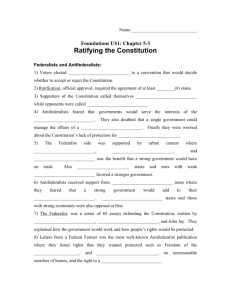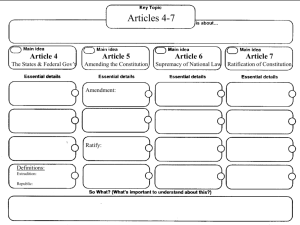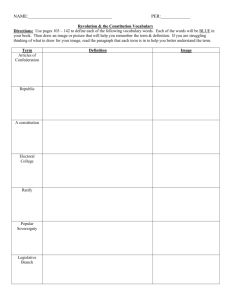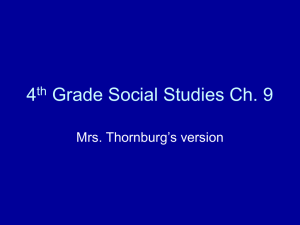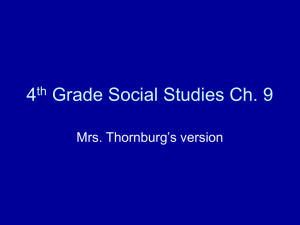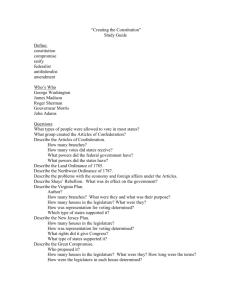First Political Parties and Ratification Debate (12/16 and 12/17)
advertisement
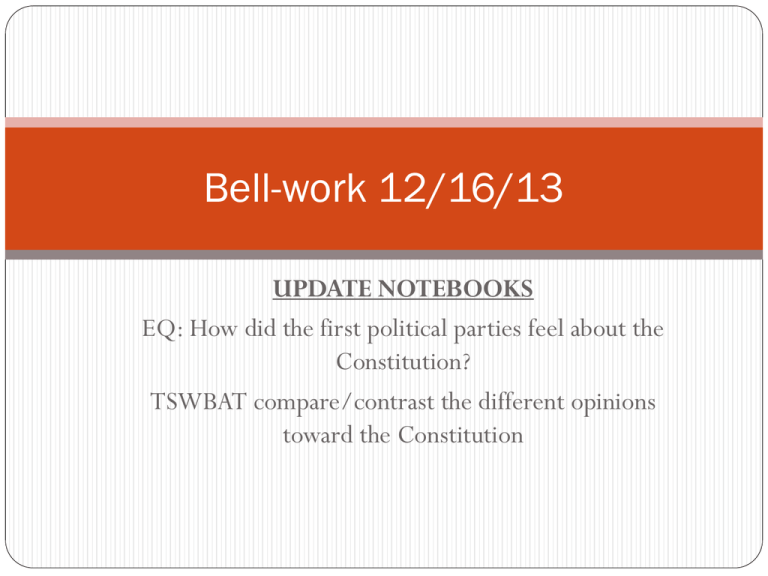
Bell-work 12/16/13 UPDATE NOTEBOOKS EQ: How did the first political parties feel about the Constitution? TSWBAT compare/contrast the different opinions toward the Constitution OBJECTIVE AND SCALES: The student will be able to compare and contrast the differencing positions (Federalist versus Anti-Federalist) in regards to the Constitution with 80% accuracy What unit goal are we working toward mastery of? Yes, goal H How do you reach mastery? Foldable Ratifying the Constitution The convention had a set process for states to ratify, or approve the Constitution. Each state was to hold a state convention and decide to ratify The new gov’t would go into effect once 9 states ratified it However, two different positions about the Constitution and ratification would emerge (and these two different opinions would lead to the Nation’s first 2 political parties) The Federalist Position Were well educated and propertied class. Most lived in settled areas along the seaboard. Supported the new Constitution Articles of Confederation were weak and ineffective. Called themselves Federalists because they supported a strong Federal Government Leaders were Alexander Hamilton, John Jay, and James Madison (published the Federalist Papers) Men of experience and talent should govern the nation. The Federalist Position National government would protect the rights of the people. Constitution and state governments protected individual freedoms without bill of rights In favor of establishing the Constitution with almost any means possible. The Anti-Federalist Position States' rights advocates, backcountry farmers, poor farmers, the ill-educated and illiterate. They were opposed to a strong central government and therefore called themselves ANTI-federalists Led by George Mason and Patrick Henry Opposed to ratification of the Constitution the way it was. Agreed the AOC were not strong enough, but felt the Const. Convention had gone too far Opposed strong central government. Strong national government threatened state power. Strong national government threatened rights of the common people. The Anti-Federalist Position Constitution favored wealthy men and preserved their power. Constitution lacked a bill of rights. Argued against 2/3 ratification plan. Summary and Progress Chart On the back of your comparison chart summarize the key arguments of each faction and explain with what argument you agree regarding the Constitution and why. Complete progress chart for goal H Test is coming this week, are you achieving mastery? Bell-work 12/17/13 Look at the political cartoon shown on page 220 Answer the two evaluation questions (A) and (B) Also, why do you think Virginia was being “placed” by the hand? Only 8 more days…have you been good?! EQ: Why was it difficult to ratify the Constitution? TSWBAT understand the debate for ratification Objective and Scales: The student will be able to understand the difficulty of ratification and the debates with 80% accuracy What goal are we striving to reach MASTERY of today? Goal I What is mastery of goal I? Notebook Quiz Please get out a blank sheet of paper, a pen/pencil, and your notebook You desk should be clear of all but the items above The quiz is ten questions (2 pts each) Good luck! 1. Delaware First to ratify December 7, 1787 Vote: 30 for, 0 against 2. Pennsylvania 2nd to ratify December 12, 1787 Vote: 46 for, 23 against 3. New Jersey 3rd to ratify December 18, 1787 Vote: 38 for, 0 against 4. Georgia 4th to ratify January 2, 1788 Vote: 26 for, 0 against 5. Connecticut 5th to ratify January 9, 1788 128 for, 40 against. 6. Massachusetts Anti-federalists hoped to win this state Opposition to ratification was strong due to Shay’s rebellion But, became the 6th state to ratify after strong Federalist campaign February 6, 1788 187 for, 168 against 7. Maryland 7th state to ratify April 28, 1788 Vote: 63 for, 11 against 8. South Carolina 8th state to ratify May 23, 1788 Vote: 149 for, 73 against 9. New Hampshire 9th state to ratify June 21, 1788 Vote: 57 for, 47 against Constitution will go into effect 10. ** Virginia Huge win for the Federalists b/c had Virginia not ratified, other states like NY might not approve it either Patrick Henry led an attack on the Constitution in VA claiming there was no real checks or balances But James Madison warned people of the breakup of the Union and Virginia becomes the 10th state to ratify June 25, 1788 Vote: 89 for, 79 against 11. New York 11st state to ratify July 26, 1788 Vote: 30 for, 27 against 12. North Carolina 12st state to ratify November 21, 1789 Vote: 194 for, 77 against 13. Rhode Island Last state to ratify May 29, 1790 Vote: 34 for, 32 against. Summary and Progress Chart Explain why ratification was a difficult process. Explain who was campaigning in the states. Complete progress chart for I

